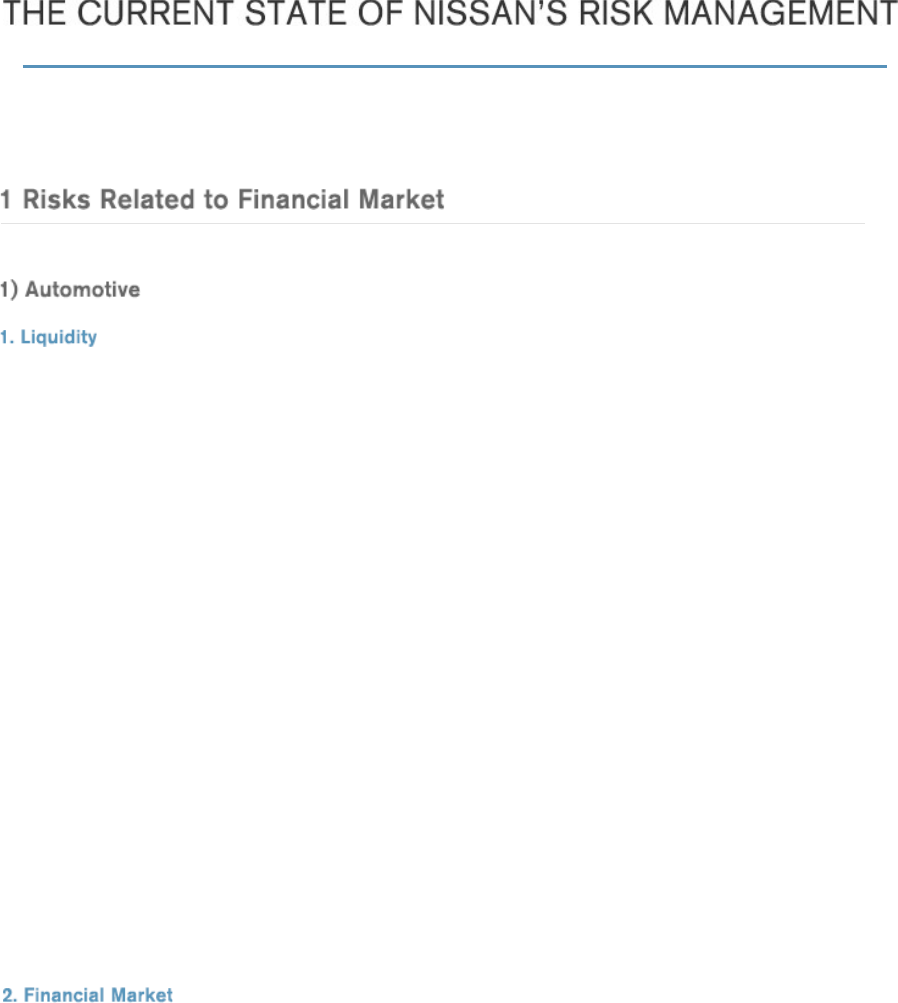
1
Below we present some of our efforts to address Nissan’s corporate risks.
An automotive business must have adequate liquidity to provide for the working capital needs of
normal day-to-day operations, ongoing research and development, capital investment needs for
future expansion and repayment of maturing debt. Liquidity can be secured through cash and
cash equivalents, internal cash flow generation and external funding.
As of the end of fiscal 2017 (March 31, 2018), Nissan’s automotive business had ¥1,140.6 billion of
cash and cash equivalents (compared with ¥1,190 billion as of March 31, 2017). In addition to cash,
Nissan had approximately ¥516 billion of committed lines available for drawing as of March 31, 2018.
As for external funding, Nissan raises financing through several sources including bond and
commercial paper issuance in capital markets, long- and short-term loans and committed credit
lines from banks.
Nissan has a liquidity risk management policy that is intended to ensure adequate liquidity for the
business while at the same time ensuring mitigation of liquidity risks such as unmanageable
bunched maturities of debt. In the policy, minimum liquidity requirements are defined taking into
consideration several factors including debt maturity, upcoming mandatory payments—such as
dividends, investments and taxes—and peak operating cash needs. We also benchmark our
liquidity targets with other major Japanese corporations and global auto companies to ensure our
assumptions are reasonable.
Nissan is exposed to various financial-market-related risks, such as foreign exchange, interest
rates and commodity prices. Although it is not possible to eliminate all the risks with the use of
derivative products, Nissan does hedge select currencies and commodity price risks on an
opportunistic basis to reduce financial market risks.
●
Foreign exchange
Nissan’s products are produced in 20 countries and regions, and are sold in more than 170
countries and regions. Nissan’s procurement activities for raw materials, parts/components and
services are conducted in many countries. Nissan faces various foreign currency exposures that
result from the currency of purchasing cost being different from the currency of sale to
2
customers.
In order to minimize foreign exchange risk on a more permanent basis, Nissan is working to
reduce foreign currency exposure by such measures as shifting production to the countries where
vehicles are sold and procuring raw materials and parts in foreign currencies.
In the short term, Nissan may limit risks in foreign exchange volatility within a certain range by
using derivative products in accordance with the internal policies and procedures for risk
management and operational rules regarding derivative transactions.
●
Interest rate
The interest rate risk-management policy is based on two principles: long-term investments and
the permanent portion of working capital are financed at fixed interest rates, and the non-
permanent portion of working capital and liquidity reserves are built at floating rates.
Nissan may hedge risks of interest rate fluctuation by using derivative products in accordance
with the internal policies and procedures for risk management and operational rules regarding
derivative transactions.
●
Commodity prices
Nissan purchases raw materials in the form of parts provided by the suppliers, as well as direct
purchase, and it is exposed to the price fluctuation risks of raw materials, no matter whether
purchased directly or indirectly.
For precious metals, which are used in catalysts, to minimize commodity price risk Nissan is
making continuous efforts to reduce usage through technological innovation. In the short term,
Nissan manages commodity price volatility exposure through the use of fixed-rate purchase
contracts in which commodity prices are fixed for a period of time; Nissan may also hedge risks in
commodity price volatility within a certain range by the use of derivative products in accordance
with the internal policies and procedures for risk management and operational rules regarding
derivative transactions.
●
Marketable securities
Nissan may hold marketable securities for various reasons including strategic holding,
relationship management and cash management. Nissan defines the authority for decision
concerning such transactions within the internal policies and procedures for risk management.
The company also takes measures for these risks including mandatory periodical reporting with
fair value of such financial transactions.

3
Nissan does business with a variety of local counterparties, including sales companies and
financial institutions in many regions around the world. Nissan is exposed to the risk that such
counterparties could default on their obligations.
Nissan has established transaction terms and conditions for operating receivables in Japan and
overseas based on credit assessment criteria. These criteria enable Nissan to take measures to
protect such receivables and may include bank letters of credit and/or advance payment
requirements.
As for financial transactions including bank deposits, investments and derivatives, Nissan
manages its counterparty risk by using an evaluation system based on external credit ratings and
other analysis. Nissan enters into such transactions only with financial institutions in each market
that have a sound credit profile within their respective countries.
Nissan has defined benefit pension plans mainly in Japan, the United States and the United
Kingdom. The funding policy for pension plans is to make periodic contributions as required by
applicable regulations. Benefit obligations and pension costs are calculated using many different
drivers, such as the discount rate and rate of salary/wage increase.
Plan assets are exposed to financial market risks as they are invested in various types of
financial assets including bonds and stocks. When the fair value of these assets declines, the
amount of the unfunded portion of pension plans increases, which could materially increase
required cash pension contributions and pension expenses.
As countermeasures to manage such risks, the investment policy of these pension plans is based
upon the liability profile of the plans, long-term investment views and benchmark information
regarding asset allocation of other global corporations’ pension plans.
Nissan holds Global Pension Committee meetings on a periodic basis to review investment
performance, manager performance and asset allocations and to discuss other issues related to
pension assets and liabilities.
Nissan operates majority-owned captive sales finance companies in Japan, the United States,
Canada, Mexico, China, Australia, New Zealand, Thailand, Indonesia and India. In addition,
Nissan is also a minority shareholder in a sales finance company (bank) in Russia. In these
countries, banks and other financial institutions also provide financing solutions to Nissan’s
customers and dealers.
In Europe and other regions, RCI Banque and several other banks/financial institutions are
providing financing to Nissan’s customers and dealers.
We monitor the liquidity of sales finance companies on an ongoing basis to ensure we have
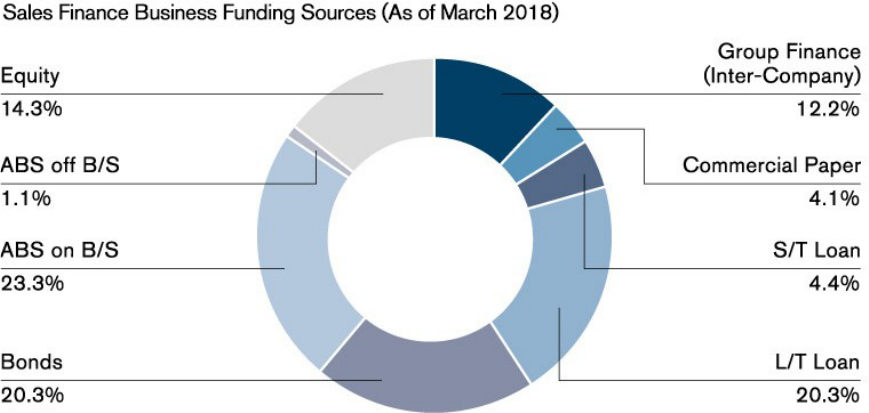
4
adequate liquidity to meet maturing debt and continue operations. According to its policy, Nissan
targets to match maturity of liabilities with maturity of assets wherever possible. In some of the
countries where Nissan operates, long-term capital markets are not developed and thus it is not
always possible to be perfectly match-funded. Match-funding policy allows us to meet maturing
debt obligations even in an environment in which we cannot raise additional debt due to the state
of capital markets.
In addition to match-funding, we manage liquidity risk in sales financing through several
measures including keeping adequate liquidity in the form of cash and unutilized committed lines,
unencumbered assets (mainly vehicle loans and leases), liquidity support from auto operations to
the extent we have excess cash in auto operations, diversified funding sources and geographical
diversification of capital market access.
As of March 31, 2018, sales finance companies’ liquidity (cash and unutilized committed lines)
was approximately ¥925.4 billion. Additionally, we have a healthy mix of secured (24.4%) and
unsecured and other (75.6%) funding sources, which support a stronger balance sheet and
incremental liquidity through utilization of unencumbered assets.
The pie chart below describes our diversified funding sources in the sales finance business.
During fiscal 2017, we were able to raise new funding through bank loans, asset-backed
securities, asset-backed commercial paper, commercial paper and bonds reflecting our diversified
access to financing instruments.
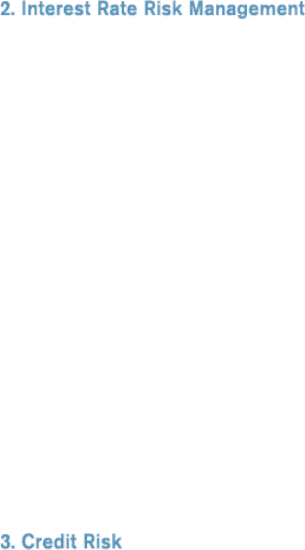
5
The sales finance business is exposed to interest rate risks. Interest rate risk is defined as the
potential variance in the earnings of an entity or the fair value of the portfolio that would result from
a fluctuation in the general level of market interest rates where funds with differing fixed- rate
periods or differing terms are financed and invested.
Nissan measures the risks by using the sensitivity analysis with various interest rate scenarios and
determines the risk tolerance level. Nissan controls the interest rate maturities of both assets and
liabilities to maintain the risks within an acceptable tolerance level.
The sensitivity analysis mentioned above uses statistical models, such as the Monte Carlo
Simulation Method; however, the actual fluctuation of market interest rates and its impact may
deviate significantly from the assumptions used in the models. Nissan enters into interest rate
derivative financial instruments to maintain the potential variability of interest rates at the desired
level of risk exposure. The main objective of these transactions is to mitigate the risks and not to
pursue speculative profit maximization.
Credit risk is the potential for loss due the failure of counterparties in the consumer lending and
dealer finance business to meet their credit obligations as agreed. Nonperformance may be
driven by changing economic conditions, deterioration in financial stature of a dealer or
individual, or other unexpected events.
Nissan manages credit risk through a framework that sets out policies, procedures,
measurements and regular reviews across the full life cycle of a financial product from
underwriting to collections and write-off.
In consumer lending, applicants undergo a comprehensive screening process to establish their
credit worthiness. To measure credit worthiness, Nissan uses credit scoring systems that assign a
credit score to an applicant on the basis of data provided by the credit bureaus and/or data
provided by the applicant on the credit application. The underwriting decision is then Bon an
automated or expert judgement process that includes assessment of the credit score, applicant’s
capacity to pay, available capital, debt repayment history, vehicle collateral and financing
conditions. If necessary, and based on regional business practices, further telephone or field visit
verifications may be undertaken. For dealer finance, each application for a new credit limit,
change to credit limits or annual re-approval of credit limits goes through an extensive
committee-based evaluation and decision process. The evaluation focuses on the dealer’s
financial standing, internal rating, capacity to service debt, operational performance,
appropriateness of the request, and the availability and amount of guarantees and collateral. The
internal rating system used during the evaluation is based on a dealer scoring model taking into
account key financial performance metrics and at times results of operational performance.
All scoring models for consumer lending and for dealer finance undergo regular reviews and
revisions to keep them up-to-date and applicable for current credit applications. These models
have direct impact on pricing where risk-based pricing is practiced and/or applicable and in

6
addition regulate stock audit frequency for dealer floorplan financing.
As a matter of accounting policy, Nissan maintains adequate credit loss provisions to cover any
future probable credit losses; however, Nissan also takes all necessary measures to collect on
outstanding bad debt promptly. Depending on region collections may utilize behavioral scoring,
auto-dialer systems, call queue optimization or external third-party collection agencies to
maximize recovery of outstanding debt.
Residual value risk is the risk where the future market value of a vehicle is lower than the
guaranteed end-of-term residual value for such financial products as operating leases and some
balloon-type loans. Nissan is exposed to residual value risk if a customer exercises the option to
return a vehicle to Nissan and subsequently the vehicle is sold in the market for less than the
residual value.
To mitigate this risk Nissan takes a number of steps, both operational and strategic. On an
operational level residual values are set objectively based on third-party independent evaluation
(e.g. Automotive Leasing Guide in North America) and/or on statistical analysis of historical
used-car market data (e.g. in Japan). On a strategic level, to build brand value and hence
increase future market value of Nissan vehicles, Nissan takes steps to control the level of sales
incentives on new vehicles, maintain appropriate levels of fleet sales and promote certified pre-
owned vehicles.
Nissan evaluates the recoverability of carrying value of its vehicles versus estimated future
market values on an ongoing basis. Per accounting policy, if an impairment is identified Nissan
recognizes an appropriate provision for potential residual value losses.
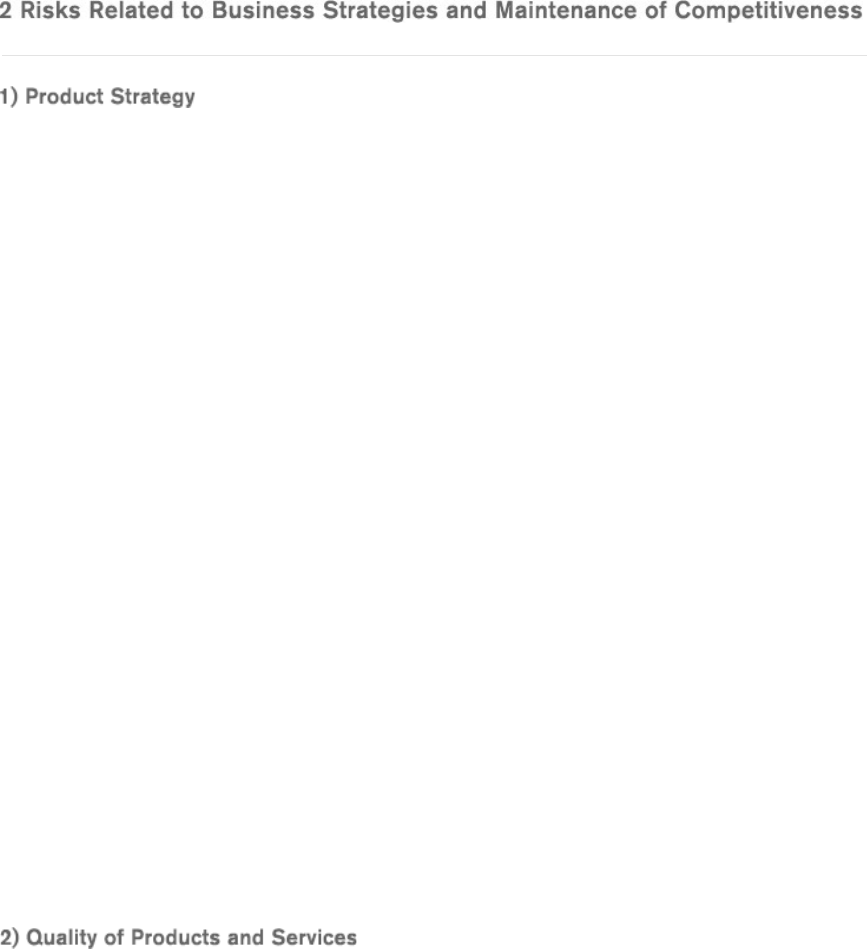
7
To secure profitability and sustainable growth based on the future product lineup plan, as part of
its product strategy developing process Nissan monitors the impact of various risk scenarios—
such as global market changes and demand deteriorations—on its future profitability based on
the plan.
Risk Scenario Examples:
1.
Drastic decline of total global demand
2.
A demand shift between vehicle segments drastically faster than Nissan’s midterm planning
assumptions
3.
A demand shift from mature markets to emerging markets drastically faster than Nissan’s
midterm planning assumptions
The company periodically monitors the impact of these scenarios to secure future profitability
and sustainable growth, as well as updating its future lineup plan periodically based on the
results. To improve the robustness of its product lineup against these risks, the company’s main
approach is to take the following countermeasures when planning its product strategy:
•
Expand availability of individual products across markets to mitigate the risk of single-market
demand fluctuations.
•
Increase volume and efficiency per product through a consolidation and rationalization of the
portfolio to lower the breakeven point and thereby reduce the profit risk of global total industry
volume (TIV) declines.
•
Prepare a more balanced product portfolio meeting needs in a broader range of markets and
segments, reducing reliance on specific large markets.
The Nissan M.O.V.E. to 2022 midterm plan (up to fiscal 2022) establishes product quality and
customer-centric focus as the foundation of Nissan’s business, while also setting numerical
targets and promoting them across the whole company.
With respect to new model projects, in order to achieve quality targets, milestone meetings are
held for processes from design, production preparation and production, at which key check
points are confirmed, such as achievement of quality targets, prevention of recurring problems,
and adoption of measures for potential risks related to new technology and mechanisms and
design changes. Commercial production can be started after confirmation at the Start of
Production (SOP) Judgment Meeting, which confirms all issues are solved and quality targets can
be achieved. The final decision that the model can be sold is made at the Delivery Judgment
Meeting after confirmation of the quality of commercial production and preparedness for

8
service/maintenance.
Nissan is implementing thorough quality checks before new model launches. Nissan is advancing
quality improvement activities after launch as well by constantly gathering quality information
from markets and promptly deploying countermeasures if problems arise. In case safety or
compliance issues do occur, necessary actions such as recalls are implemented with close
cooperation with the marketing side based on a management decision reached by an
independent process. Incidents are thoroughly investigated and analyzed, and the lessons are
applied to existing or upcoming models to prevent a recurrence.
In addition to these activities, such as quality assurance for new model projects and quality
improvement activities on a daily basis, the company has introduced and operates a “Quality Risk
Management” framework. The framework represents a higher-level system to ensure successful
quality management for both ongoing and future projects. Appraisal involves an objective
evaluation of whether risk exists and the level of such risk for the company and the assignment of
responsible persons based on the level for follow-up activities. These processes are implemented
by the Quality Risk Management Committee, chaired by an executive tasked with heading this
activity, twice a year.
The automotive industry is affected globally and throughout its value chain by various regulations
and social requirements related to the environment and safety, such as exhaust emissions,
CO
2
/fuel efficiency, fossil fuel restrictions, noise, chemical substances, recycling, and effects on
water resources, ecosystems and other natural capital, while these regulations are getting more
stringent year by year. To meet these requirements, Nissan formulates an environmental strategy
based on materiality assessments of management risk factors, analyzing the company’s potential
issues and opportunities and identifying issues that are crucial for both Nissan and its
stakeholders.
In this context, Nissan believes that one effective solution from a long-term perspective will be the
widespread use of zero-emission vehicles. Nissan started sales of Nissan LEAF, the world’s first
affordable, mass-produced EV, in 2010. The Renault-Nissan-Mitsubishi Alliance also has a goal
of maintaining EV leadership toward 2022, and is considering partnering with national and local
governments to promote zero-emission mobility and to help build a supporting infrastructure.
Nissan will help to reduce CO
2
emissions by continuously developing technologies to improve fuel
efficiency in internal combustion engines and bringing them widely into the market. In particular,
the company will promote highly fuel-efficient, low CO
2
emitting vehicles equipped with such
technologies as its flagship e-POWER electrification technology and revolutionary variable
compression ratio turbo engine, fuel-efficient direct injection engine and continuously variable
transmission (CVT).
Stricter controls on environment-impacting substances are being implemented in countries
around the world. In accordance with a globally uniform policy on reducing the use of
9
environment-impacting substances, Nissan is strengthening its management of environment-
impacting substances, adhering to a well-planned schedule for their reduction and advancing the
use of alternative substances. In 2005, the company drew up policies regarding the use of
substances scientifically recognized as being hazardous or carrying high hazard risks, as well as
those identified by NGOs as dangerous. In 2007, these policies became unified global standards
for Nissan, and in 2016 they were issued as common technology standards for the Alliance,
restricting environment-impacting substances to a stricter degree than the domestic laws of the
countries and regions where it operates. Based on this approach, Nissan has developed internal
engineering standards restricting the use of designated substances. The standards identify the
chemicals whose use is either prohibited or controlled, and they are applied in selecting the
materials, parts and articles for Nissan vehicles from the stage of initial development.
Demand for mineral resources and fossil fuels has steadily increased in response to the
economic growth of emerging countries. In addition to promoting reduced use of virgin natural
resources through resource-saving and resource-recycling measures, it is becoming important to
procure natural resources that have a lower impact on the Earth’s ecosystems, not only from the
standpoint that these resources are limited (including the mineral resources for motor and battery
applications, the use of which is expected to increase with electrification) but also considering the
wide-ranging effects that resource extraction has on ecosystems. Nissan’s aim is that by 2022
some 30% of the resources used in the manufacture of its vehicles will not rely on newly mined
resources. To achieve this, the company considers vehicle lifecycle and promotes weight
reduction, less use of scarce resources, less waste and increased use of recycled materials.
Additionally, Nissan promotes rebuilding, remanufacturing, and reuse to maximize opportunities
for recapturing the residual value of cars and parts.
Air pollution, along with climate change and traffic congestion, is one of the issues facing urban
areas, and one which it is necessary for Nissan as an automobile manufacturer to address and
contribute to solving.
The spread of EVs, such as the Nissan LEAF, that emit absolutely no exhaust gas during
operation is an effective way to improve atmospheric pollution levels in urban areas. Nissan, as a
leader in this field, promotes zero-emission mobility and investigates the setting up of
infrastructure through forming partnerships with national and local governments, as well as
various industry groups such as electric power companies.
Meanwhile, typical emissions from manufacturing plants include nitrogen oxide (NOx), sulfur
oxide (SOx), and volatile organic compounds (VOCs). Nissan is carefully putting in place global
management standards and systems for these and other substances released into the
atmosphere, while working to reduce the amount of these materials used and emitted. Nissan’s
goal is to address these issues in a way than goes beyond the level of local regulations.
The issue of water resources is ever more serious with the retreat of glaciers and rainfall
fluctuation due to climate change, in addition to increasing water use due to the growing world
population and economic development. Nissan, which uses water resources in its production
process, seriously recognizes the importance of this issue and continuously works to preserve
10
water resources at plants around the world, such as by reducing consumption, recycling water
discharged in the production process and thorough water quality control of waste water.
The purchasing divisions of Nissan and Renault carry out supply-chain management in a manner
consistent with The Renault-Nissan Purchasing Way, a booklet outlining policies for dealing with
suppliers, and the Renault-Nissan CSR Guidelines for Suppliers. With respect to environmental
issues, Nissan has set standards for the efforts of its automobile parts and material suppliers in
the form of the Nissan Green Purchasing Guidelines. Since fiscal 2012, Nissan has asked
suppliers to report on environmental data, including their CO
2
emission levels and energy use,
and also to provide reports on management of environment-impacting substances, recycling of
resources and water-conservation efforts. Nissan then works with suppliers to reduce
environmental impact throughout the value chain.
Nissan is working to achieve guidelines and targets as part of its corporate social responsibility
as well as to comply with laws and regulations. In order to address diversifying environmental
issues and promote comprehensive environmental management on a global basis, the Global
Environmental Management Committee (G-EMC), which is co-chaired by a board member and
convenes twice a year, and the Environmental Management Committees (EMCs) in six regions
worldwide confirm the progress of activities and decide companywide policy and the content of
reports to the Board of Directors.
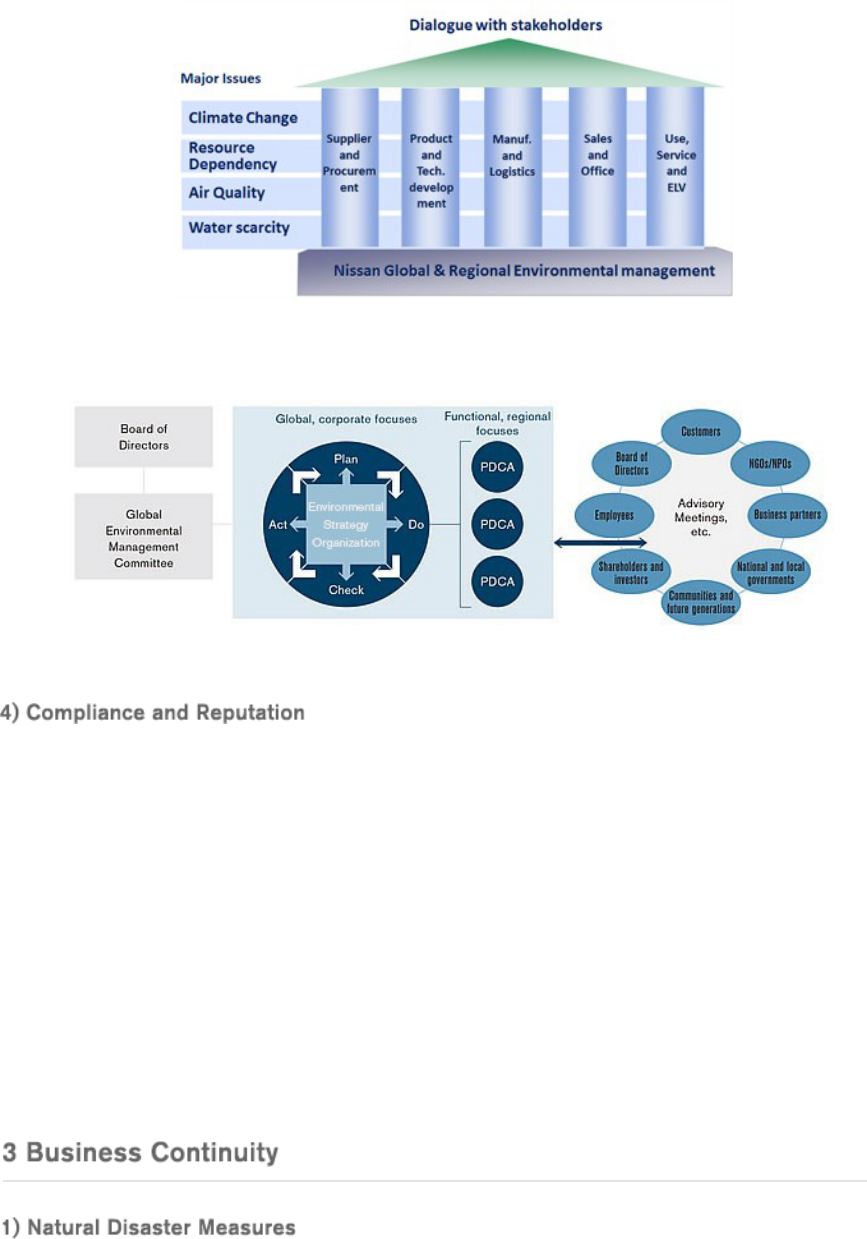
11
Nissan’s Framework for Global Environmental Management
.
Nissan’s Global and Regional Environmental Management Organization
Nissan produced a Global Code of Conduct for all employees of the Nissan Group worldwide. To
ensure thorough understanding of the code, training and education programs such as e-learning
are provided and the company’s compliance with laws and ethical standards is monitored by
regional and local compliance committees, which report to the Global Compliance Committee.
Nissan has also implemented a globally integrated whistleblowing system. This allows employees
to report suspected compliance issues to Nissan’s management.
Nissan also has created sets of internal regulations globally covering the prevention of insider
trading, personal information management, information security and prevention of bribery and
corruption. Nissan makes efforts to prevent noncompliance and reputation risk to the company by
implementing various education and training programs.
In case of an earthquake measuring 5-upper or higher on the Japanese seismic intensity scale or
other natural disasters causing heavy damage affecting Nissan’s business activities, a First
12
Response Team (organized by the main units of the Global Disaster Headquarters) will gather
information and decide actions to be taken based on the information. If necessary, the Global
Disaster Headquarters and Regional Disaster Headquarters will be set up to gather information
about employees’ safety and the damage situation of facilities and to work for business continuity.
At the same time, Nissan is working with suppliers to develop a Business Continuity Plan (BCP).
This includes assessment of the priority of work by each and every function and development of
countermeasures to continue priority work. The BCP will be reviewed annually in the process of
the PDCA cycle.
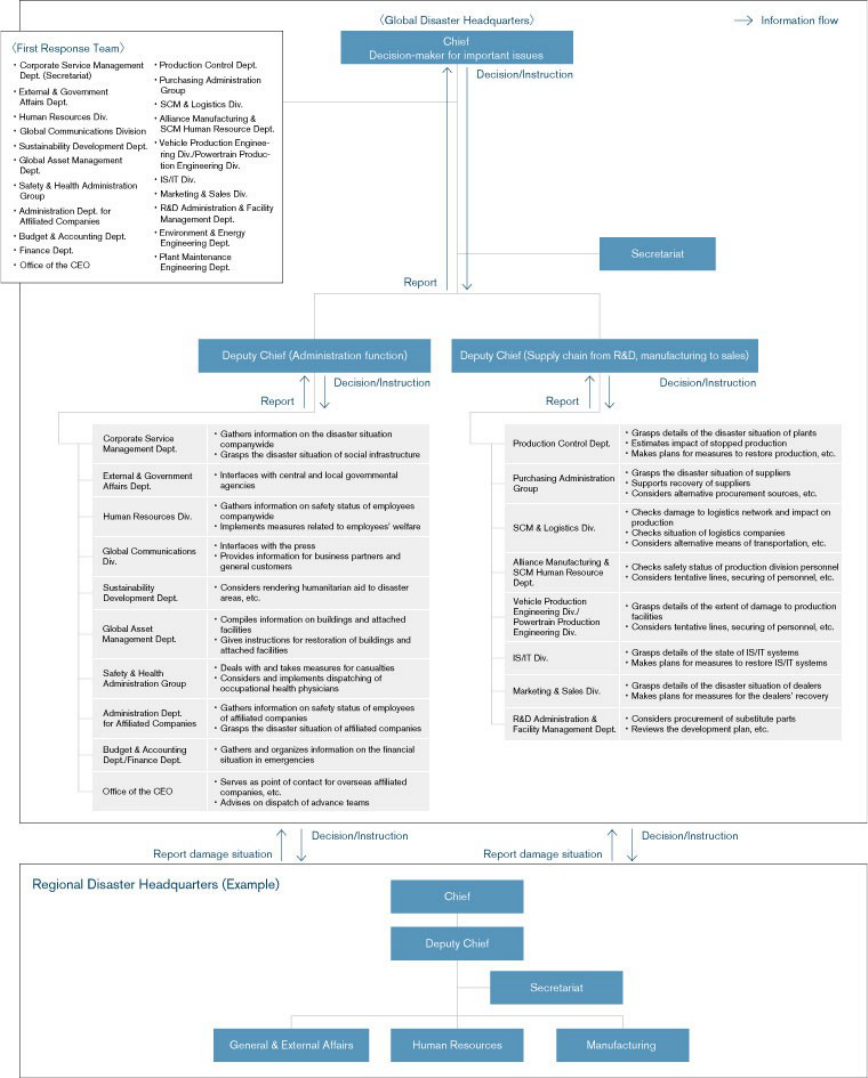
13
Organization for Disaster Recovery (Earthquake)
.
14
Policy and Principles in Case of Earthquake:
1.
Human life as the first priority (utilization of employee safety confirmation system)
2.
Prevention of secondary disaster (in-house firefighting organization, stockpiling, provision of
disaster information)
3.
Speedy disaster recovery and business continuity (measures for hardware, improvement of
contingency plan and development of BCP)
4.
Contribution to local society (cooperation/mutual aid with neighboring communities,
companies, local and central governments)
The Global Disaster Headquarters and Regional Disaster Headquarters conduct simulation
training assuming a large earthquake to prepare for a catastrophe. The drills test the
effectiveness of this organization and contingency plan and identify the issues to be improved.
The contingency plan is reviewed based on the feedback.
In the aftermath of the March 11, 2011, disaster, Nissan’s periodic simulation training helped to
ensure the smooth launch of its Global Disaster Headquarters and Regional Disaster
Headquarters on the initiative of the First Response Team. This also helped to complete
confirmation of employees’ safety and checks on the extent of the damage.
Additionally, based on the policy of contribution to local society, the company reacted rapidly to
provide rest space for people who could not return home on March 11 and to support damaged
areas.
At the stage of business recovery, the Disaster Headquarters and the project teams of each
function continuously shared up-to-date information and were addressing the issues for
production and business recovery with companywide cooperation. Effective communications
supported the quick recovery of Nissan’s total supply chain, including parts supply, production,
logistics, sales and services.
The response to the March 2011 disaster was reviewed during fiscal 2011 to identify issues that
came to light on a function-by-function basis and to consider countermeasures.
In March 2012, simulation training was conducted based on a new scenario incorporating the
review findings, and the new measures were verified.
In fiscal 2012, Nissan conducted simulation training based on a conducted based on a scenario of
a combined Tokai, Tonankai and Nankai earthquake, confirming preparedness for issues that
came to light during drills held the preceding fiscal year, such as responses to wide-area
disruptions to its logistics network and fuel shortages.
From fiscal 2013 to fiscal 2015, simulation training was based on a high-risk scenario of an
earthquake directly beneath the Tokyo metropolitan area based on the latest estimates from the
Cabinet Office. This disaster would result in widespread power cuts, limited communications and
other problems. In conducting this simulation training, the company was able to confirm methods
of information exchange and cooperation between relevant departments. Departments also
worked together to consider how to respond to inherent issues of individual departments as well

15
as those that affected multiple departments.
Additionally, Nissan has formed groups of employees who live near work sites and would be able
to get to those sites if a disaster struck on a nonwork day. The company held training for these
employees to prepare to set up Disaster Headquarters on nonwork days.
In fiscal 2016, Nissan considered how to respond to a situation similar to the April 2016
earthquakes in Kumamoto Prefecture. The company conducted initial response training based on
a scenario in which an active fault earthquake takes place at night or on a holiday. Regular
annual simulation training was based again on a scenario of three simultaneous earthquakes.
The company identified further issues arising when the affected area is large and is working to
address these. The company will enhance its disaster measures by applying the PDCA cycle to
training based on newly emerging issues and recent changes in the government’s anticipated
seismic scale announcements.
In the face of its expanding global operations and the need to enhance the natural disaster
response of its overseas facilities, in fiscal 2012 Nissan began undertaking horizontal
development of best practices at each facility and inviting overseas personnel to observe the
simulation training held in Japan. In addition, the same year it started communication training
among its overseas facilities based on scenarios of major disasters in various regions of the
world. This training is held regularly four times a year.
In fiscal 2013, Nissan developed visualization tools for assessing the effectiveness of disaster
countermeasures in the countries where it operates. Based on the tools, Nissan conducts a PDCA
cycle program on an ongoing basis to increase its global disaster preparedness. The Global
Headquarters building, where the Disaster Headquarters for Japan has been set up (built in
August 2009), has an earthquake-resistant structure using vibration-controlling brace dampers.
Safety is assured even in the case of a maximum-level earthquake at the site.
In response to the outbreak of H1N1 type influenza in April 2009, Nissan established a global
policy for infection prevention. Each region has organized a response team and has promoted
concrete countermeasures based on the policy. Infection status can be monitored globally thanks
to firmly developed reporting lines between the global response team and each regional team.
Nissan has promoted countermeasures based on three basic principles stated in the global policy,
which are:
1.
Priority on employees’ health and lives
2.
Prevention of the spread of infection
3.
Continuity of business operation
As specific actions, Nissan established the “guidelines for employees’ action,” which stipulated
actions to be taken by employees, sections and companies, and kept employees informed.
Nissan also developed a BCP for each business section, with several triggers to invoke the BCP
depending on the infection ratio, to maintain business continuity even under a high infection
situation.

16
Nissan will keep prepared for contingencies like avian flu through its PDCA cycle, such as by
updating response team members and the BCP, carrying out educational activities for infection
prevention and stockpiling sanitary and medical goods.
Nissan’s production division has dealt with various risks related to the three elements of
production, as listed in the chart below. For natural disasters, the company has identified the
measures needed to restart production within its established goal of two weeks following a large-
scale disaster. Over the years Nissan has carried out continuous prevention countermeasures to
physical infrastructure (quake proofing and reinforcement of buildings and other facilities),
maintained an operations recovery manual to shorten recovery time and regularly executed BCP
simulation drills. The company is also strengthening the resilience of its global production network,
such as by establishing a BCP for parts exports to enable continued operations at overseas
plants.
To prepare for the risks associated with its worldwide expansion of production, Nissan has
designated critical facilities around its global network that would play major roles in ensuring
business continuity. The company is working to bolster preventive maintenance by ensuring
thorough knowledge of globally standardized facility maintenance guides. At the same time, to
minimize impact on production, Nissan is drawing up backup plans for implementation in the
event of a significant disruption.
In addition, it is vitally important to manage risks associated with parts procured from Leading
Competitive Countries (LCCs) in order to expand markets. Nissan has been conducting risk
assessment before making sourcing decisions and providing support for improvement activities
after sourcing. As part of preparations for production, the company carries out assessments of
quality and of quantity management processes. In the production phase, quality checks are
implemented at key points in the production and logistics process to prevent the production and
utilization of imperfect parts. The company also works to reinforce measures identifying the root
causes of issues in order to secure global market expansion and growth. To efficiently and
effectively promote these activities, Nissan is globally standardizing tools and practices for
improving processes and assessments. Through organizations to manage supplier risk in major
regions, including North America, Europe, China, Japan, Thailand, India and Brazil, Nissan is
reinforcing efforts to prevent risks associated with parts supply.
Meanwhile, it has also become vital to prevent the increasing number of cyberattacks, and also
to minimise the effect on Nissan when they occur. At the same time as monitoring and managing
all IT equipment and PCs at manufacturing plants, Nissan takes preventative action to avoid risk
by installing anti-virus software on that equipment and performing equipment lifecycle
assessments. Additionally, in order to minimize damage in the very unlikely event that a
cyberattack occurs, Nissan periodically conducts simulation training for first response teams and
business continuity planning.
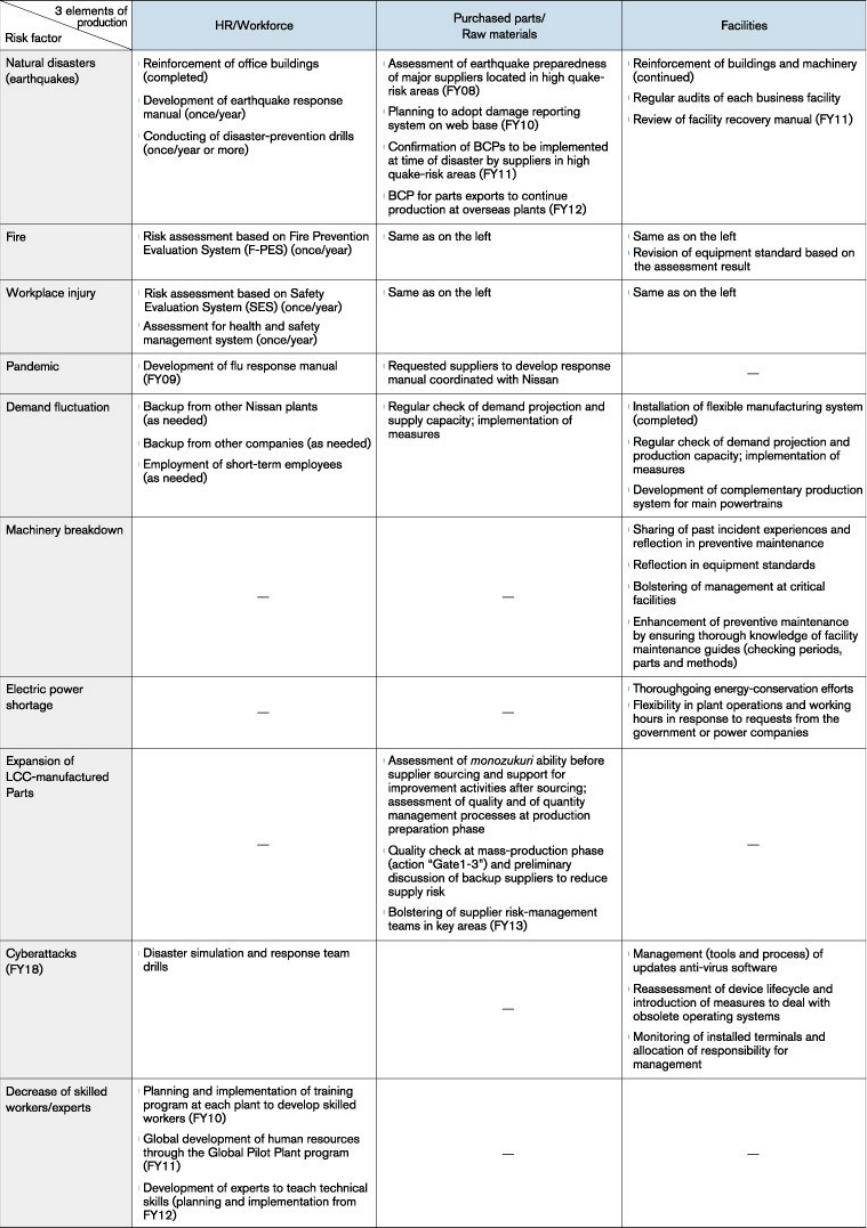
17

18
To minimize risk in the supply chain, Nissan has prepared policies for both major disasters and daily risks,
following up on their execution.
•
Promotion of BCPs
1.
Identification of risks and drawing up of recovery plans
Identify risks from natural disaster and single-source risks and work with suppliers to prepare and maintain
up-to-date production recovery plans for suppliers in risk areas and high-risk components.
2.
Visualization of the supply chain
Create and maintain an updated supply-chain database including suppliers, their components and their
materials to quickly understand the damage to suppliers when a major earthquake strikes, in order to
provide those heavily affected with rapid support and to ensure early resumption of Nissan vehicle
production.
3.
Improvement of BCPs
Continue visits to suppliers, introducing benchmark examples. Also conduct BCP Checklist surveys for
assessing supplier BCP systems and activities, communicate and implement follow up activities on the
results. The surveys added floods, labor strikes and terrorist risk to the existing categories of earthquakes
and tsunamis and expanded the scope of suppliers questioned on a global basis.
4.
Assessment of suppliers’ financial risk
Conduct financial assessment of suppliers globally, including those for Renault, on a daily basis and
communicate closely to ensure maintenance of sound business.
1.
Global Insurance Management Policy
Nissan manages hazard risk on a global basis with risk-management techniques that combine self-retained
risk with external risk transfer via insurance.
In order to minimize the cost of risk, Nissan adheres to the following global insurance management policy.
This policy has provided appropriate coverage for damage resulting from the unpredictable disasters that
the world has seen in recent years.
•
Predictable risks with low impact and high frequency:
Retain risks up to an acceptable level on a consolidated basis by the company.
•
Unpredictable risks with low frequency and high impact or shock value:
Risks whose financial impact may exceed the acceptable level of self-retention are transferred outside the
company via insurance.
2.
Global Insurance Programs
In order to minimize the cost of hazard risks and manage risks occurring globally and interdependently in a
concentrated manner, global insurance programs have been established for main lines of insurance. The
Finance Department in the Global Headquarters decides insurance conditions and structures and
19
negotiates directly with insurance companies for these global programs. The insurance companies are
important strategic partners, and they are thus selected in consideration of risk spread and financial
solvency.
The following risks are covered through global programs.
•
Property damage and business interruption by accidents:
The program covers risks not only for property damage but also for business interruption and contingent
business interruption due to accidents, taking into consideration the global expansion of the supply chain for
products and parts. Nissan identifies important suppliers globally and arranges insurance for risks caused
by interruption of the supply chain. Coverage limits are determined based on the probable maximum loss
amount measured by third-party experts and the risk appetite of insurers.
Nissan achieved further improvement and optimization of insurance conditions by negotiating with
insurance companies together with its Alliance partner Renault from fiscal 2011. Nissan also extended the
program to new Alliance partner Mitsubishi Motors Corp. from fiscal 2017.
•
Transportation and storage of vehicles and products for sales:
This program covers risks relating to transportation and the supply chain for parts and products globally. By
covering risks spread geographically under a global program, Nissan can manage loss data on a global
basis and ensure stability of insurance costs.
In fiscal 2011, this program was combined with Renault’s program for negotiating with insurance companies
to achieve best possible results utilizing synergies of scale. Nissan also extended the program to new
Alliance partner Mitsubishi Motors from fiscal 2017.
•
Liability (including product liability and liability for unanticipated accidents during operations or caused by
owned or managed facilities [general liability]):
To manage this risk, Nissan has implemented insurance programs suitable for the legal systems and
practices in each region. The programs are led by the Global Headquarters in order to implement a
globally uniform strategy with consistent worldwide insurance coverage, and to achieve lower insurance
costs.
3.
Utilization of Group Insurance Company
For the purpose of more efficient self-retention on a consolidated basis for insurance programs, Nissan
utilizes an insurance company of the Nissan Group.
Utilization of a Group insurance company enables the following:
•
Company can reduce insurance costs by obtaining the minimum necessary insurance.
•
Each Group company can obtain necessary coverage.
•
Company can gather and analyze loss data below self-retained limit.
4.
Loss Prevention Activities
Nissan conducts loss prevention activities to improve loss results and reduce the cost of premiums on an
ongoing basis. Since the global insurance programs have been introduced, loss prevention activities have
been promoted more actively and globally to maintain low premium rates. Examples of Nissan’s loss
prevention activities include conducting risk-engineering surveys and obtaining recommendations for safety
from third-party experts, creating manuals for actions in the event of typhoons and constructing hail nets to
prevent hail damage.
